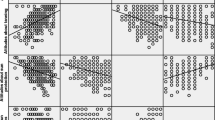Abstract
Sunbathing and sunscreen use, as well as related intentions, attitudes, beliefs, and knowledge, were assessed in 90 Southern Appalachian undergraduates. A large majority (75%) reported sunbathing, with more than half reporting sun lamp use. A slight majority (56.7%) reported some use of sunscreen. Subjects reporting an intention to tan spent more time sunbathing, both outside and under a sun lamp. Individuals reporting a sun protection intention had lighter tans and spent less time sunbathing. Sunbathing was predicted by perceptions of sunbathing as relaxing, while sun lamp use was predicted by more positive views of suntatns. Sunscreen use was predicted by more positive sun protection attitudes and less negative sunscreen attitudes.
Similar content being viewed by others
References
American Academy of Dermatology (1988).Americans Know Risks, Sun Themselves Anyway, American Academy of Dermatology, Evanston, IL.
American Academy of Dermatology (1989).Melanoma/Skin Cancer: You Can Recognize the Signs, American Academy of Dermatology, Evanston, IL.
Adams, P. J., and McGlynn, F. D. (1995). Skin cancer education increases knowledge, not precautionary practices among coeds. Paper presented at the meeting of the Southeastern Psychological Association, Savannah, GA, Mar.
Azjen, I., and Fishbein, M. (1980).Understanding attitudes and Predicting Social Behavior, Prentice-Hall, Englewood Cliffs, NJ.
Banks, B. A., Silverman, R. A., Schwartz, R. H., and Tunnessen, W. W. (1992). Attitudes of teenagers toward sun exposure and sunscreen use.Pediatrics 89: 40–42.
Bausell, R. B. (1986). Health-seeking behavior among the elderly.Gerontologist 26: 556–559.
Broadstock, M., Borland, R., and Gason, R. (1992). Effects of suntan on judgments of healthiness and attractiveness by adolescents.J. Appl. Soc. Psychol. 22: 157–172.
Cockburn, J., Hennrikus, D., Scott, R., and Sanson-Fisher, R. (1989). Adolescent use of sun-protection measures.Med. J. Austral. 151: 136–140.
Fears, T., and Scotto, J. (1982). Changes in skin cancer morbidity between 1971–1972 and 1977–1978.J. Natl. Cancer Inst. 69:365–370.
Fears, T., Scotto, J., and Schneiderman, M. (1977). Mathematical models of age and ultraviolet effect on the incidence of skin cancer among whites in the United States.Am. J. Epidemiol. 105: 421–428.
Fitzpatrick, T. B. (1975). Soleil et peau.J. Med. Esthet. 2:33–34.
Fleming, J. S., and courtney, B. E. (1984). The dimensionality of self-esteem. II. Hierarchical facet model for revised measurement scales.J. Personal. Soc. Psychol. 46: 404–421.
Goldsmith, M. F. (1987). Paler is better, say skin cancer fighters.J. Am. Med. Assoc. 257: 893–894.
Hill, D., White, V., Marks, R., Theobald, T., Borland, R., and Roy, C. (1992). Melanoma prevention: Behavioral and nonbehavioral factors in sunburn among an Australian urban population.Prev. Med. 21: 654–669.
Jaccard, J., and Becker, M. A. (1990).Statistics for the Behavioral Sciences, 2nd ed., Wadsworth, Belmont, CA.
Janis, I. L., and Field, P. B. (1959). Sex differences and factors related to persuasibility. In Hovland, C. I., and Janis, I. L. (eds.),Personality and Persuasilibity, Yale University Press, New Haven, CT.
Keesling, B., and Friedman, H. S. (1987). Pschosocial factors in sunbathing and sunscreen use.Health Psychol. 6:477–493.
Kopf, A., Rigel, D., and Friedman, R. (1982). The rising incidence and mortality rate of malignant melanoma.J. Dermatol. Surg. Oncol. 8: 760–761.
Kricker, A., Armstrong, B. K., English, D. R., and Heenan, P. J. (1995). A dose-response curve for sun exposure and basal cell carcinoma.Int. J. Cancer 60: 482–488.
Leary, M. R., and Jones, J. L. (1993). The social psychology of tanning and sunscreen use: Self-presentational motives as a predictor of health risk.J. Appl. Soc. Psychol. 23: 1390–1406.
Lillquist, P. P., Baptiste, M. S., Witzigman, M. A., and Nasca, P. C. (1994). A population-based survey of sun lamp and tanning parlor use in New York State, 1990.J. Am. Acad. Dermatol. 31: 510–512.
Lombard, D., Neubauer T. E., Canfield, D., and Winett, R. A. (1991). Behavioral community interventions to reduce the risk of skin cancer.J. Appl. Behav. Anal. 24:677–686.
Malouff, J., Schutte, N., and Tokarz, B. (1992). Beliefs, behavior, and sun-related skin damage. Paper presented at the Southeastern Psychological Association Conference, Knoxville, TN, Mar.
Mermelstein, R. J., and Riesenberg, L. A. (1992). Changing knowledge and attitudes about skin cancer risk factors in adolescents.Health Psychol. 11:371–376.
Miller, A. G., Ashton, W. A., McHoskey, J. W., and Gimbel, J. (1990). What price attractiveness? Stereotype and risk factors in suntanning behavior.J. Appl. Soc. Psychol. 20: 1272–1300.
Miller, D. L., and Weinstock, M. A. (1994). Nonmelanoma skin cancer in the United States: Incidence.J. Am. Acad. Dermatol. 30: 774–778.
Pathak, M. A. (1991). Ultraviolet radiation and the development of non-melanoma and melanoma skin cancer: Clinical and experimental evidence.Skin Pharmacol. 4(Suppl. 1):85–94.
Rosenstock, I. M. (1974). The health belief model and preventative health behavior.Health Educ. Monogr. 2: 354–386.
Vitaliano, P., and Urbach, F. (1980). The relative importance of risk factors in non-melanoma carcinoma.Arch. Dermatol. 116:454–456.
Walter, S. D., Marrett, L. D., From, L., Hertzman, C., Shannon, H. S., and Roy, P. (1990). The association of cutaneous malignant melanoma with the use of sunbeds and sunlamps.Am. J. Epidemiol. 131: 232–243.
Westerdahl, J., Olsson, H., and Ingvar, C. (1994). At what age do sunburn episodes play a crucial role for the development of malignant melanoma.Eur. J. Cancer 30A: 1647–1654.
Westerhof, W., Estevez-Uscanga, O., Meens, J., Kammeyer, A., Durocq, M., and Cario, I. (1990). The relation between constitutional skin color and photosensitivity estimated from UV-induced erythema and pigmentation dose-response curves.J. Invest. Dermatol. 94: 812–816.
Wichstrom, L. (1994). Predictors of Norwegian adolescents' sunbathing and the use of sunscreen.Health Psychol. 13: 412–420.
Author information
Authors and Affiliations
Rights and permissions
About this article
Cite this article
Hillhouse, J.J., Stair, A.W. & Adler, C.M. Predictors of sunbathing and sunscreen use in college undergraduates. J Behav Med 19, 543–561 (1996). https://doi.org/10.1007/BF01904903
Received:
Issue Date:
DOI: https://doi.org/10.1007/BF01904903




